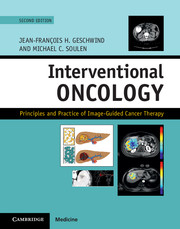Book contents
- Frontmatter
- Contents
- List of contributors
- Section I Principles of oncology
- Section II Principles of image-guided therapies
- Section III Organ-specific cancers – primary liver cancers
- Section IV Organ-specific cancers – liver metastases
- 16 Colorectal masses: Ablation
- 17 Assessment, triage, and chemoembolization for colorectal liver metastases
- 18 Radioembolization for colorectal liver metastases
- 19 Assessment, triage, and liver-directed therapies for neuroendocrine tumor metastases
- 20 Preoperative portal vein embolization
- Section V Organ-specific cancers – extrahepatic biliary cancer
- Section VI Organ-specific cancers – renal cell carcinoma
- Section VII Organ-specific cancers – chest
- Section VIII Organ-specific cancers – musculoskeletal
- Section IX Organ-specific cancers – prostate
- Section X Specialized interventional techniques in cancer care
- Index
- References
19 - Assessment, triage, and liver-directed therapies for neuroendocrine tumor metastases
from Section IV - Organ-specific cancers – liver metastases
Published online by Cambridge University Press: 05 September 2016
- Frontmatter
- Contents
- List of contributors
- Section I Principles of oncology
- Section II Principles of image-guided therapies
- Section III Organ-specific cancers – primary liver cancers
- Section IV Organ-specific cancers – liver metastases
- 16 Colorectal masses: Ablation
- 17 Assessment, triage, and chemoembolization for colorectal liver metastases
- 18 Radioembolization for colorectal liver metastases
- 19 Assessment, triage, and liver-directed therapies for neuroendocrine tumor metastases
- 20 Preoperative portal vein embolization
- Section V Organ-specific cancers – extrahepatic biliary cancer
- Section VI Organ-specific cancers – renal cell carcinoma
- Section VII Organ-specific cancers – chest
- Section VIII Organ-specific cancers – musculoskeletal
- Section IX Organ-specific cancers – prostate
- Section X Specialized interventional techniques in cancer care
- Index
- References
Summary
Once considered rare, the incidence and prevalence of neuroendocrine tumors (NET) have increased rapidly, with a more than fivefold increase in incidence in the USA from 1973 to 2004 and a prevalence that is two to five times that of esophageal cancer, gastric cancer, pancreatic cancer, and hepatobiliary cancer (Figure 19.1). The typically long delay in diagnosis of NETs and their propensity for hepatic metastases create an important role for liver-directed therapies. Challenged by the shortage of physicians experienced in the diagnosis and management of this disease, these long-lived patients often access strong advocacy groups and web-based support sites which direct them to centers of excellence with physician teams that offer a complete understanding of the spectrum of their disease. It is essential that interventional oncologists develop an intimate knowledge of the characteristics and management of NETs in order to know how and when best to apply the armamentarium of image-guided therapies, and guide patients in integrating these with surgical, systemic, and supportive therapies.
Defining neuroendocrine disease
Terminology
Comprising a spectrum of epithelial neoplasms that originate from cells which synthesize peptide hormones released in response to a neuronal stimulus, neuroendocrine neoplasms may develop sporadically or as part of familial syndromes including multiple endocrine neoplasia, von Hippel–Lindau syndrome, and neurofibromatosis. These neoplasms most often originate from the foregut gastroenteric, pancreatic, and pulmonary tissues but may arise from any organ given the widespread distribution of neuroendocrine cells within the body.
The World Health Organization (WHO) Classification of Tumours of the Digestive System of 2010 addresses the classification of gastroenteropancreatic NETs. This classification focuses on the major criteria determining malignant potential, including tumor histopathology or differentiation, grade, site, size, and stage, with the premise that all neuroendocrine neoplasms have malignant potential. Tumor differentiation describes the extent to which the neoplasm resembles its non-neoplastic counterpart. Tumor grade is based on proliferative activity, as determined by the number of mitoses per unit area of tumor (mitoses per 10 high-power microscopic fields or per 2 mm2) or by the proliferative index (the percentage of cells immunolabeling for Ki-67). Grades 1 and 2 imply well-differentiated histopathology based on the proliferative index, with the term carcinoma restricted to grade 3, which includes high-grade, poorly differentiated large-cell or small-cell neuroendocrine carcinomas. The WHO classification system replaces previous terminology, including carcinoid and apudoma, as well as descriptions of embryonic origin (Table 19.1).
- Type
- Chapter
- Information
- Interventional OncologyPrinciples and Practice of Image-Guided Cancer Therapy, pp. 165 - 175Publisher: Cambridge University PressPrint publication year: 2016

